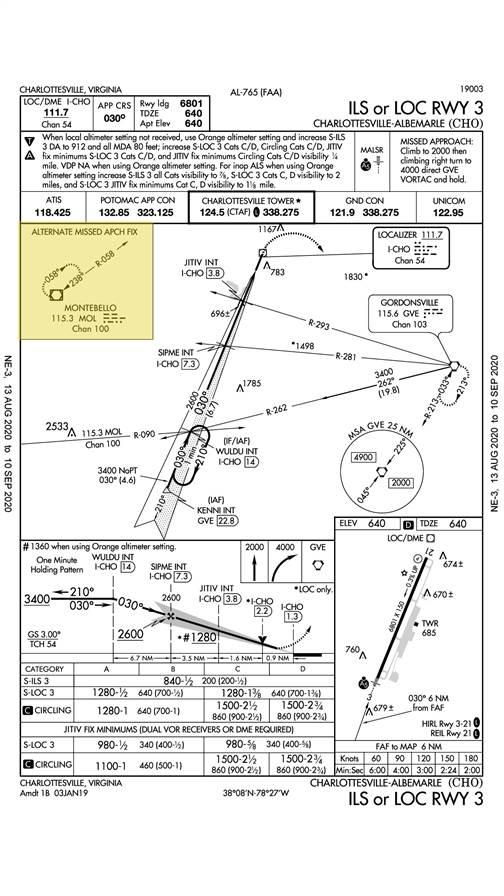Instrument Tip: Missed opportunity
Flying the alternate procedure
 A little confused, you brief that missed approach procedure as the action in case you have to go missed. Was that the right call?
A little confused, you brief that missed approach procedure as the action in case you have to go missed. Was that the right call?
In a word, no. Alternate missed approach fixes are partially charted procedures found on most approaches that are dependent on ground-based navaids. Thus, most ILS, localizer, VOR, and NDB approaches will include an alternate missed approach fix. Although the fix and its associated hold are depicted in the box, you won’t find route information from the missed approach point or decision height to the alternate fix, and you won’t find a textual description like the one in the upper right for the primary missed approach procedure.
That’s because the FAA wanted to make it clear that the primary missed approach procedure is just that. When a controller clears you for the approach, she also clears you to fly the missed approach procedure without any further instructions. So, why include an alternate missed approach fix so prominently in the plan view? It can be confusing, but there’s an important reason to include an alternate.
Approaches with ground-based navaids as the primary means of navigation have a significant drawback. The equipment requires regular maintenance and is subject to interruption from nearby maintenance as well. Airport personnel might be working on an ASOS, for example, which could take a part of the approach offline. If that piece of equipment is required for the missed approach, it would take down the entire approach. Many missed approaches are based upon a nearby VOR, and if that VOR is down, no one can fly the approach. By establishing an alternate missed approach fix that’s based on another navaid, the approach can continue to stay live.
Employing the alternate missed can take on a few forms. If the FAA knows the primary missed approach will be unavailable because of a navaid outage, a notam can be issued that indicates the alternate missed approach is in effect. Often the clues are a notam for the navaid outage, and a discussion of the new missed approach. When the Halfway VOR in Minnesota was down recently, a notam was issued for the ILS or LOC 30 at Owatonna Degner Regional that said, “ILS OR LOC RWY 30, AMDT 3... MISSED APPROACH: CLIMB TO 2000 THEN CLIMBING LEFT TURN TO 3000 DIRECT MKT VOR/DME AND HOLD, FOW VOR/DME OUT OF SERVICE.” The approach plate lists MKT as the alternate missed approach fix, and the hold is depicted as well.
Sometimes navaids go down unexpectedly, and controllers must transition to the alternate missed approach quickly. In these cases the controller will read the alternate missed approach information from their published guidance. As the FAA’s controller handbook says, “Alternate missed approach procedures…require a detailed clearance when they are issued to the pilot.” If you want to study your home airport’s alternate missed approach procedures, search the FAA’s website for “Airport Procedures Information Gateway,” type in the airport identifier, and click on “IFP Documents” after your airport’s results come up.
By charting the hold and the alternate missed approach fix, the controller doesn’t have to issue extensive holding instructions. Instead, she can give the routing and instruct to hold as published.
One of the unusual aspects of an alternate missed approach fix is that you may be unequipped to fly it. An instrument approach procedure is named after the equipment required to fly the approach. The ILS Runway 3 at CHO requires a VOR with glideslope, for example. That’s evident in the name and by looking at the approach plate. But some alternate approach fixes are dependent on a navaid not otherwise required for the approach. A VOR approach could have an alternate missed based on an NDB, or vice versa.
According to the Aeronautical Information Manual a pilot can reject the alternate missed procedure if it is received prior to beginning the approach. But once the approach has begun, the pilot must fly the alternate missed, request a new approach (presumably with a different missed fix), or request an alternate action, such as a different destination.
Given the high-stress environment of an approach in weather, you can imagine the challenges of setting up an alternate missed at the last minute. To add to that confusion, according to PilotWorkshops, alternate missed approach procedures won’t be found in the GPS database. If navigating by GPS, you would have to suspend the primary missed and manually enter the alternate missed fix as a standalone routing.
It’s all confusing enough to make any pilot want to stick only to GPS approaches.



